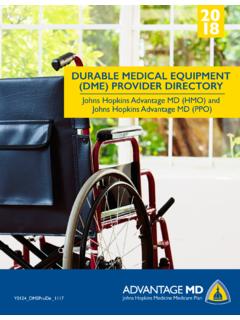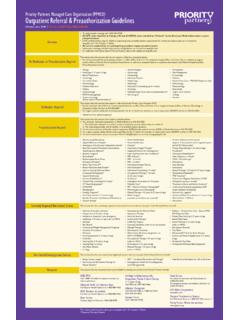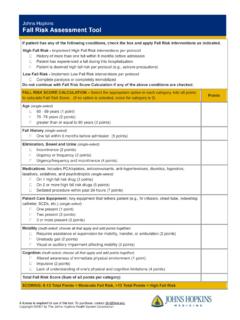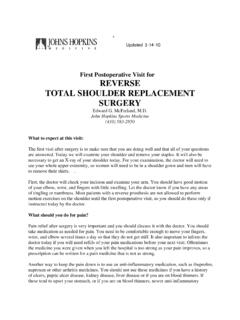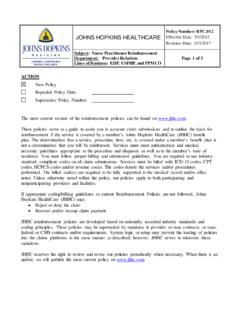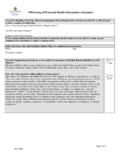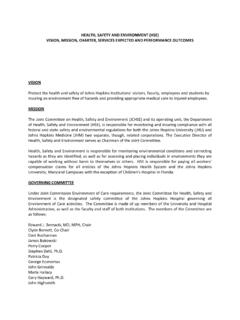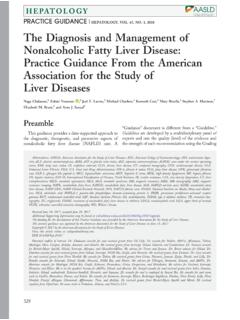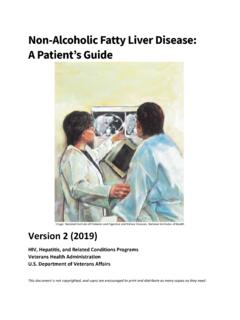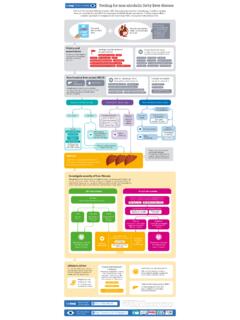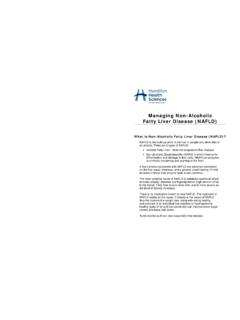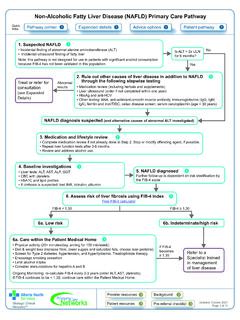Transcription of Alcoholic Liver Disease: Introduction - Hopkins Medicine
1 Figure 1..Location of Liver in Liver Disease: Introduction Alcohol is used by approximately 75% of the population of the United States, with a 7% incidence of alcoholism. In addition, alcoholaccounts for approximately 100,000 deaths in the each year, with nearly 20% of those deaths attributable to dependence and/or abuse rates are higher for men than women and for non-blacks than blacks (though blacks have ahigher rate of cirrhosis). Alcohol abuse presents serious public health and social problems, all of which are preventable. What is Alcoholic Liver Disease?As the name implies, Alcoholic Liver disease is Liver injury attributed to alcohol abuse. The majority of Americans manage to drink alcohol without seriousconsequences. Research suggests, however, that Liver disease may begin to develop after a "threshold" dose of alcohol has been consumed generally assumed tobe four drinks a day (four 12 ounces beers, four glasses of wine, or four ounces of hard liquor) for men, and one half that quantity for women.
2 Nearly everyone whoconsumes this amount or more will have some evidence of Liver injury, although less than 50% will develop serious Liver disease. SymptomsThe range of clinical features of Alcoholic Liver disease varies, from asymptomatic to end-stage Liver disease with portal hypertension, jaundice and encephalopathy(Figure 6). Patients may present with nonspecific digestive tract symptoms such as nausea, dry retching, diarrhea, anorexia, and abdominal pain but often they waituntil severe Liver decompensation forms before consulting a physician. Patients may also seek medical attention as a result of the consequences of alcoholism, whichmay include accidents, violent behavior, depression, tremors, poor work performance, or social Liver is usually asymptomatic. On evaluation hepatomegaly is present in 70% of patients and there may be mild abnormalities in with Alcoholic hepatitis may also be asymptomatic. Hospitalized patients usually have jaundice and hepatomegaly and may exhibit ascites, encephalopathy,and fever depending on the severity of their disease.
3 Figure 2. Signs and symptoms of alcohol-related Liver patients with alcohol-induced cirrhosis have hepatomegaly and/or splenomegaly. Clinical presentation is similar to other forms of end-stage Liver disease butmay be accompanied by concurrent Alcoholic hepatitis. Spider angiomata are frequently found in this patient population, along with palmar erythema, enlargement ofparotid and lacrimal glands, testicular atrophy, ascites, venous collaterals, jaundice and encephalopathy. HistologyAlcoholic Liver disease is defined by three stages of Liver damage following chronic heavy alcohol consumption: fatty Liver , Alcoholic hepatitis, and fibrosis/cirrhosis(Figure 5). However, the assumption that Alcoholic Liver disease always progresses linearly from Alcoholic fatty Liver , to Alcoholic hepatitis and ultimately to cirrhosis isnot correct. Stages of histologically detectable Liver damage often overlap and some cases of Alcoholic Liver disease never progress, regardless of the patient scontinued ethanol abuse.
4 fatty Liver , or steatosis, is an abnormal accumulation of fat in the parenchymal cells of the Liver and can occur within hours of significant alcohol intake. In the majorityof patients (90%) it is associated with palpable Liver enlargement. Fat deposits accumulate predominantly in the central and mid-zonal areas of the Liver (zones 3 and2) and may be macrovesicular (large droplets) or microvesicular (small droplets). Other conditions, such as nonalcoholic fatty Liver disease, drug toxicity and fatty liverof pregnancy may cause steatosis that is indistinguishable from Alcoholic fatty Liver . fatty Liver is a completely reversible lesion, assuming the patient abstains of chronic heavy alcohol users develop Alcoholic hepatitis and most will have no symptoms. The prognosis is variable and depends on the severity ofdisease. Classic signs of Alcoholic hepatitis include fatty changes, necrosis of Liver cells, Mallory bodies and perivenular inflammatory infiltrates (especiallyneutrophils).
5 Mallory bodies, eosinophilic collections of intermediate filaments found in the cytoplasm, are detected in most patients with Alcoholic hepatitis but alsooccur with other Liver (or scar formation) first begins in the pericentral zone and then progresses if injury continues. If fibrosis is found on biopsy, it predicts a progression tocirrhosis or end-stage Liver disease. Alcoholic cirrhosis is of the micronodular type. The normal lobular architecture is obscured and central veins are difficult to amount of fat is variable and Alcoholic hepatitis may or may not be present. Continuing necrosis and fibrosis results in the progression from a micro- to amacronodular pattern. This progression is accompanied by a reduction in steatosis in end-stage Liver disease. Cirrhosis is not reversible. Copyright 2001-2013 | All Rights North Wolfe Street, Baltimore, Maryland 21287 Alcoholic Liver Disease: Anatomy The Liver is the largest organ in the abdominal cavity and the most complex (Figure 7).
6 It consists of a myriad of individual microscopic functional units called Liver performs a variety of functions including the removal of endogenous and exogenous materials from the blood, complex metabolic processes including bileproduction, carbohydrate homeostasis, lipid metabolism, urea formation, and immune Liver is located in the right upper quadrant, between the fifth intercostal space in the midclavicular line down and the right costal margin. It weighs approximately1800 grams in men and 1400 grams in women. The surfaces of the Liver are smooth and convex in the superior, anterior and right lateral regions. Indentations fromthe colon, right kidney, duodenum and stomach are apparent on the posterior surface. Figure 4. Anatomy of the Liver ; A, gross view; B, histological (microscopic) line between the vena cava and gallbladder divides the Liver into right and left lobes. Each lobe has an independent vascular and duct supply. The lobes aredivided into eight segments each containing a pedicle of portal vessels, ducts, and hepatic portal venous system extends from the intestinal capillaries to the hepatic sinusoids (Figure 8).
7 This system carries blood from the abdominal gastrointestinaltract, the pancreas, the gallbladder and the spleen back to the heart (coursing through the Liver ). The largest vessel in this system is the portal vein, which is formedby the union of the splenic vein and superior mesenteric veins. The left gastric and right gastric veins and the posterior superior pancreaticoduodenal vein draindirectly into the portal vein. The portal vein runs posterior to the pancreas and its extrahepatic length is anywhere from 5 to 9 centimeters. At the porta hepatis, itdivides into the right and left portal veins within the Liver , and the cystic vein typically drains into the right hepatic branch. Figure 5. Anatomy of the portal venous portal vein supplies 70% of the blood flow to the normal Liver , but only 40% of the Liver oxygen supply. The remainder of the blood comes from the hepatic artery,and blood from both vessels mixes in the Liver receives a tremendous volume of blood, on the order of liters per minute.
8 This dual blood supply from the portal vein and hepatic artery allows theliver to be relatively resistant to hypoxemia. Unlike the systemic vasculature, the hepatic vascular system is less influenced by vasodilation and vasoconstriction. Thisis due to the fact that sinusoidal pressures remain relatively constant in spite of changes in blood flow. A classic example is hepatic vein occlusion resulting in highsinusoidal pressure and extracellular extravasation of fluid. To maintain a constant inflow of blood, hepatic artery blood flow is inversely related to portal vein flow. Thisappears to be hormonally mediated rather than neurally mediated, since it persists even in the transplanted Liver . Copyright 2001-2013 | All Rights North Wolfe Street, Baltimore, Maryland 21287 Alcoholic Liver Disease: Causes Introduction Although alcohol ingestion is required to develop Alcoholic Liver disease, not everyone who consumes the "threshold dose" of alcohol will develop the , nearly 50% of individuals who ingest large amounts of ethanol are spared serious injury.
9 In addition to the amount and duration of alcohol use, severalother factors have been linked to an increased risk for the development of Liver disease. These include genetics, gender, viral Liver disease, nutrition, and exposure toother hepatotoxins. Genetics Polymorphisms exist in the enzymes ADH, CYP2E1, and ALDH. Differences in ADH and ALDH certainly contribute to the negative association with ethanoldependence in some Asian populations. HLA phenotypes, a genetic predisposition toward alcoholism and female gender may also contribute to overall risk. Viral Liver Disease Concurrent viral hepatitis increases the incidence of Liver injury in alcoholics. Studies have shown that alcoholics co-infected with hepatitis C virus (HCV), (but notnecessarily hepatitis B virus), develop Liver injury at a younger age and with a lower cumulative dose of alcohol than those not infected with HCV. These patients alsohave a much higher chance of developing cirrhosis and hepatocellular cancer compared to alcoholics without hepatitis C (Figure 9).
10 Figure 6. B, Hepatitis B virion; C, Hepatitic C virion. Nutrition Initial hypotheses suggested that Alcoholic Liver disease was a result of alcohol intake in the face of poor nutrition. Today, however, it is understood that whilemalnutrition may worsen the severity of disease and obesity may increase the risk of developing disease, Alcoholic Liver disease does indeed occur in well-nourishedindividuals. Nutrition probably plays a role in hepatotoxicity. Current research suggests that patients with diets deficient in essential nutrients are more susceptible tothe development of Liver damage. Alcohol ingestion promotes the absorption of iron from the intestine, increasing hepatic iron stores. Iron acts as an electron donor,accelerating the generation of unstable free oxygen radicals. In addition to contributing to membrane injury, this may also exacerbate inflammatory response. Hepatotoxin Exposure In general, two insults are worse than one. Just as viral hepatitis increases the risk to develop alcohol related Liver injury, other hepatotoxins may act synergistically oradditively with alcohol.
